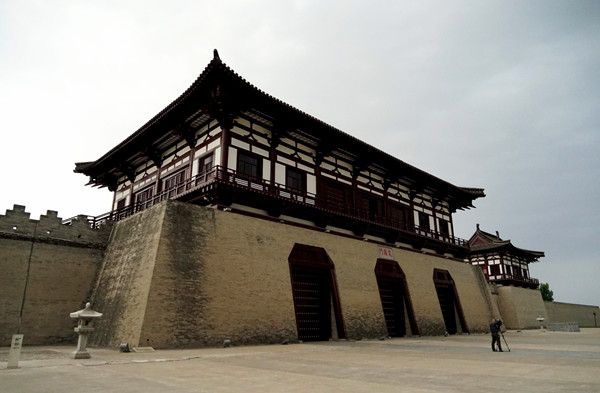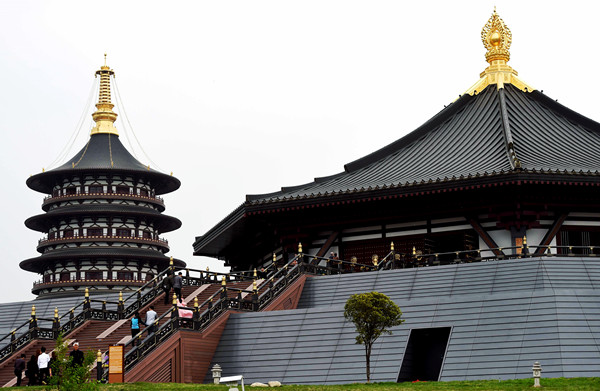
|Luoyang Dingding Gate Relics Museum of Sui and Tang Dynasties. Photo by Li An
Before the mid-10th Century, Luoyang was the most brilliant name in China — half of its then 3,000-year-old history was about being the capital of 13 dynasties.
Home to six UNESCO World Heritage sites, Luoyang was no inferior to its western peers like Athens and Rome in history. Yet one can hardly find any obvious historical imprints in the city's modern landscape today.
Luoyang, a likely forgotten capital also overshadowed by Xi'an, another ancient capital now best known for the terracotta warriors, is keen in catching up and regaining its glory.
A massive museum on the ruins of the Xia Dynasty (2070 BC-1600 BC) started construction in June, aiming to simulate scenes from more than 3,000 years ago.
The Erlitou Relic Museum as it is called, covering about 14 hectares, is expected to be completed in October 2019 with a total cost of 630 million yuan (96 million U.S. dollars).
Discovered in 1959 in Luoyang, Erlitou was identified by archaeologists as one of the capital cities of Xia Dynasty.
The Erlitou relics make a solid evidence of China's ancient civilization as the country's earliest palace complex, bronze ware workshop, and road network were all found here, said Zhao Haitao, deputy head of the Chinese Academy of Social Sciences (CASS) Erlitou archaeological team.
Designers will apply hi-tech methods, including 3D and visual reality approaches, to reproduce ancient scenarios in the museum, said Zhao, who has taken part in the excavation since 1999.
The exhibitions must be entertaining with impressive visual effect to woo younger audiences, he said.
As one of the four greatest ancient capitals in China, together with Xi'an,Beijing and Nanjing, Luoyang is ambitious to revive its long lost glories.

|Tiantang (left) and Mingtang (right) where Empress Wu Zetian used to handle state affairs and attend Buddhist rituals. Photo by Li An
Luoyang reached its peak during Tang Dynasty (618-907). China's only empress Wu Zetian moved the capital to Luoyang from Chang'an (today's Xi'an) during her reign (690-705).
Due to wars in history and modern construction, most ancient architectures in Luoyang no longer exist.
The local government is investing billions trying to restore the grandeur of the then world's biggest city.
Luoyang has allocated 47 square kilometers of land in the downtown area with cultural relics underneath already detected, trying to restore the landscape in the Sui (581-618) and Tang dynasties, said Li Ya, Party secretary of Luoyang.
A national relics park, including a lavish reconstructed palace and pagoda built on the ancient groundsill relics, has already been opened to the public in 2015. A royal garden, Jiuzhouchi, is being built at one corner of the park.
Luoyang has a grand plan to restore the landscape along the ancient axis line, including ramparts, gates, bridges, and 103 ancient residential complexes where renowned politicians and poets once lived in.
"We will build it step by step as the investment is huge," said Li, adding that "President Xi Jinping told us to be confident in our culture. And you need something tangible that people can reach consensus on."
The Tang-style architectures are "protective sheds" in archeological terms as they were built above the foundation of the relics to avoid damage to the relics.
They at the same time can serve as tourism facilities, said Wang Ge, director of the relic protection office under the Luoyang municipal cultural heritage bureau.
The park received 850,000 tourists last year and expects 1 million this year, according to Wang.

|Tourists take a close look at the exhibits displayed in Tiantang at the Luoyang National Relics Park of Sui and Tang Dynasties. Photo by Li An
PROTECTION VERSUS DEVELOPMENT
Heritage protection always contradicts with city development as the relics area occupies a quarter of the city center. It is no easy job to keep balance as Luoyang is striving to build itself as one of the dual economic engines for Henan during fast urbanization.
"City planning and construction is intertwined with cultural relics protection. If we handle well, it will be a win-win situation, " said Li Ya.
"If we mess it up, either cultural relics contain the city development or they will be ruined," he said.
As early as the 1950s when the central government planned to build Luoyang into a major industrial base, the local government avoided building factories in the old city but set up a brand new industrial district in the suburb.
Currently there are 42,000 local residents living in the Sui and Tang cultural relics protection area.
"Some of them will be relocated and some will stay. It depends on whether their living poses a threat to the relics," said Li.
The family of Qian Binggen is among the 800 households who gave way in 2009 to the construction of the Tiangtang and Mingtang, where Empress Wu Zetian handled government affairs and attended Buddhist rituals. The relocation project alone costed Luoyang 1.35 billion yuan.
Qian, 82, had lived in a compact apartment distributed by his machinery construction employer since 1955. He was relocated to a residential complex two kilometers away.
"Who made me a neighbour of the Empress?" asked Qian, who was reluctant to move at the beginning but is ready to see the changes taking place.
The protection of the cultural relics should benefit the locals, said Du Jinpeng, a researcher with the CASS Institute of Archaeology.
Providing free entrance or building an archaeological theme park can serve as returns for the locals who sacrificed a lot for the protection efforts, he said.
Song Gaoxiang, a villager who has been a part-time worker at the excavation site for years, has high hope of the Erlitou relic museum.
"I'm planning to open a restaurant when the museum is completed," said the 53-year-old man.

